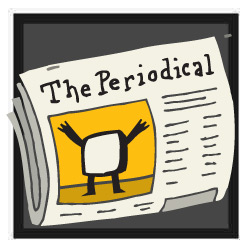Blogging the Periodic Table

Imagine that Superman's opposite-in-all-ways enemy, Bizarro, taught high-school chemistry. (Bizarro does enjoy inflicting punishment, after all ...) What sort of periodic table would hang on the wall in Bizarro's classroom? Probably the periodic table of antimatter—the anti–periodic table.
Antimatter is the mirror image of the regular old matter all around us. Instead of our negatively charged electrons, there are positively charged positrons. Similarly, our positively charged protons get inverted into negative antiprotons. There are also neutral antineutrons. And if any of these particles touch their antiparticles—if, say, an electron touches a positron—they annihilate each other in bursts of energy.
Scientists first predicted the existence of antimatter in 1928, and discovered it in 1932. The first simple antimatter nucleus (an antiproton stuck to an antineutron) was discovered a few decades later. In 1995, scientists at the CERN particle accelerator finally filled in the first spot on the anti-periodic table by creating a full-fledged antiatom—antihydrogen, with one positron circling a lone antiproton. (The antisymbol for antihydrogen is, or "h-bar.")
Because the production of antimatter takes incredible amounts of energy, and because of the short life expectancy of antimatter in our matter-rich neck of the universe, making antielements is tough work. But two recent discoveries have bolstered the hope that we can—someday—fill in more of the anti-periodic table.
In March, an international team working at Brookhaven National Laboratory announced the creation of the first nucleus of antihelium-4 (-4), the counterpart of element No. 2, helium. Scientists had created antihelium-3 before, but antihelium-4 combines more antimatter than scientists have ever seen in one place. It also supplies further proof that antimatter can bind together in stable clusters just as matter does, something scientists suspected but hadn't confirmed.
Equally important, scientists at CERN announced in late April that they'd developed a way to capture antihydrogen for the first time. Previous setups created antihydrogen at extremely high temperatures, and scientists could hold onto these antiatoms (in electric and magnetic "traps") for just fractions of a second before they flitted away. A new technique, which cools the antimatter down first, makes trapping them easier, and the CERN group held onto a cache of antihydrogen for more than 15 minutes. This technique should deepen our understanding of how to create antimatter, since scientists can now conduct detailed experiments on it for the first time. (Since antimatter opposes matter in every behavior, antihydrogen atoms should be repelled by earth's gravity and "fall up.")
When I first heard this news, I thought, Two antielements down, just 116 to go! Unfortunately, getting to the next antielement, antilithium, could take years. The production rate of antimatter drops 1,000 times for every antiproton or antineutron you have to add. So creating (which has three antiprotons, three antineutrons) would be approximately 1 million times harder than creating-4, probably beyond the reach of our current equipment.
But there might be another way to find antilithium. Scientists study antimatter partly to solve one of the deepest mysteries of the universe. The Big Bang should have created matter and antimatter in equal amounts—which means everything in existence should have annihilated itself eons ago. Yet there seems to be quite an abundance of matter around, and no one knows why. Perhaps the Big Bang didn't create equal amounts. Or, perhaps it shot massive clumps of matter and antimatter in different directions. In that case, there should be entire antimatter galaxies out there. Studying antihydrogen and antihelium should help scientists learn how to detect those antielements across deep space, in antistars. And if there's antihydrogen and antihelium out there, there's bound to be antilithium, anticarbon, antigold, and even, with some luck, anti-beings who do anti-chemistry based on their through-the-looking-glass periodic tables.